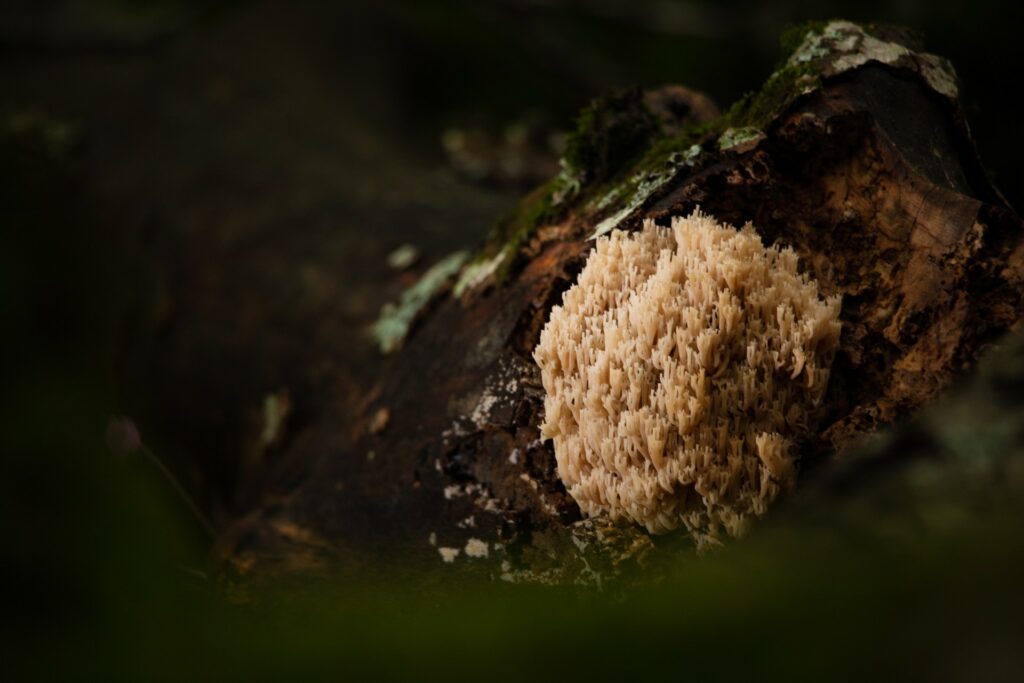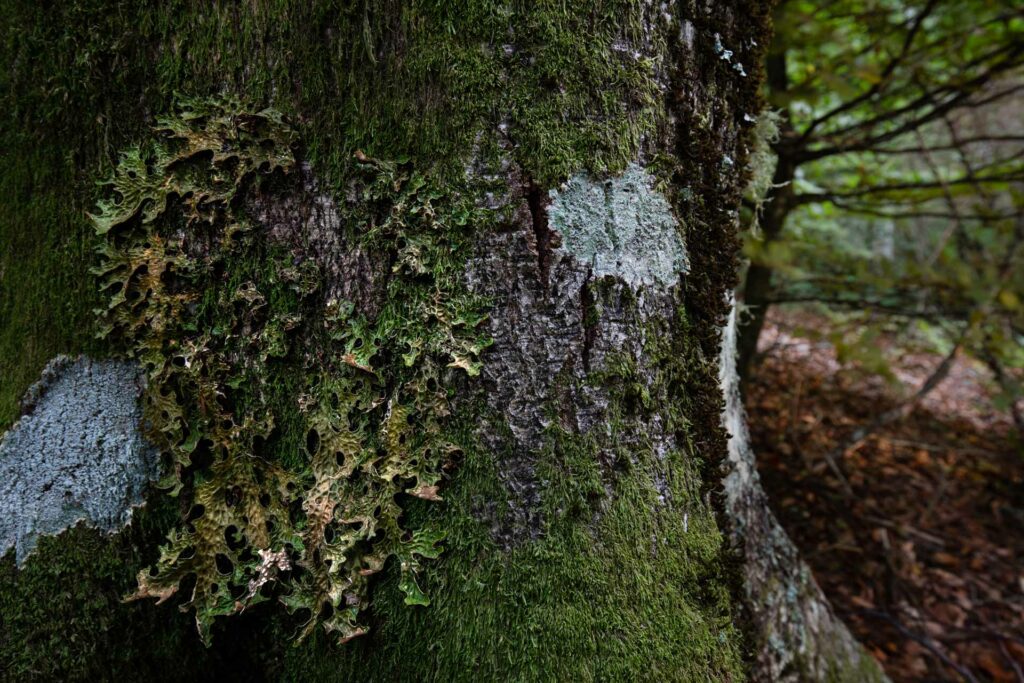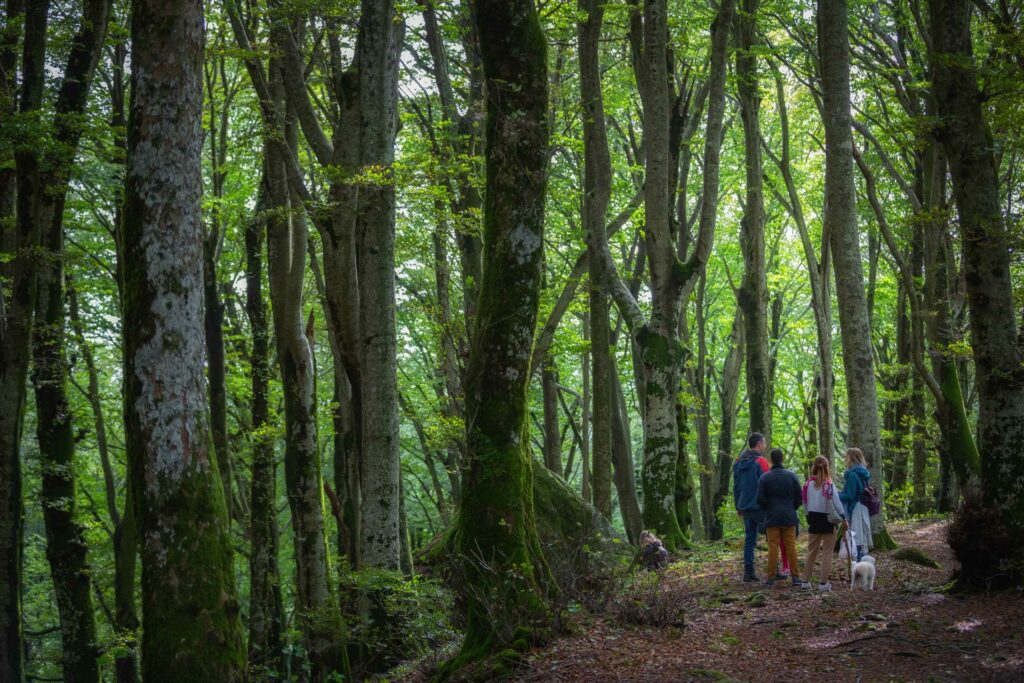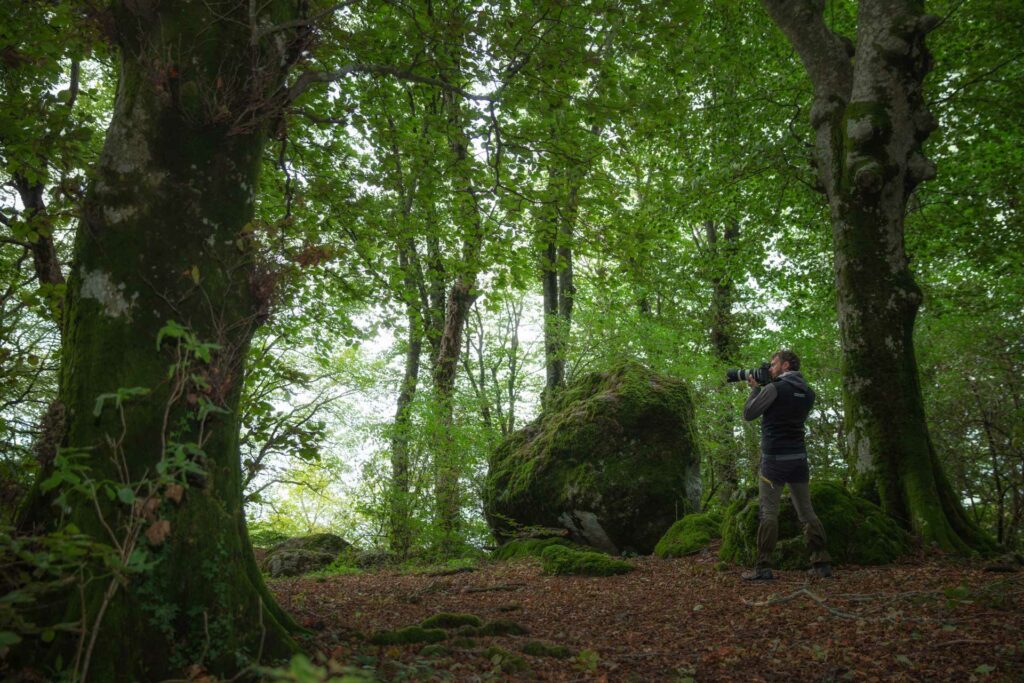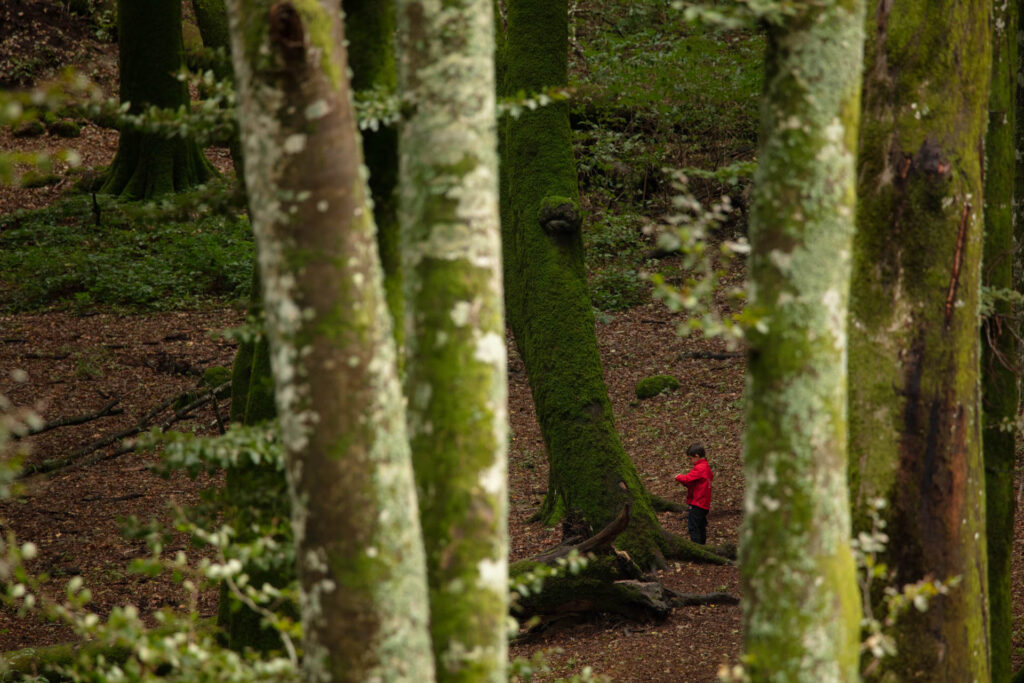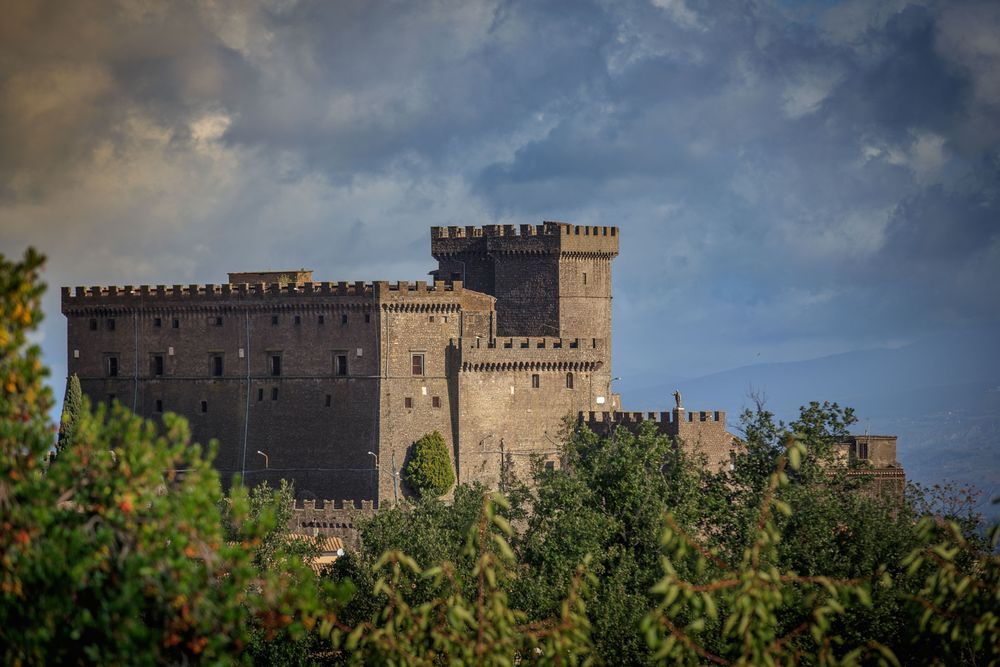Comune di Soriano nel Cimino
The area
Monte Cimino is located in a territory deeply shaped by an intense, explosive volcanic activity which affected the Province of Viterbo thousands of years ago. More exactly, the fascinating geology of Cimini Mountains dates back to a period between 1.35 million and 800,000 years ago. During this time span, the acid and viscous magmas rising through the fracture originated more than 50 hills around the main mountain, that is Monte Cimino (1,053 m).
The area is also characterized by the presence of other mountains, including Monte Montalto (786 m), Monte Roccaltia (712 m), Monte Turello (626 m) and Monte S. Antonio (617 m), all with a lava dome morphology: this means that masses of very viscous magma created uplifted areas with huge circular domes on top of them.
The altitude of the whole complex goes from 373 to 1,053 m, with an average height of 548 m. The intense volcanic activity is also demonstrated by the presence of rocky formations throughout the area: boulders with a volume of dozens of cubic meters are scattered everywhere, as reminders of the extraordinary geology of these mountains, as well as of the range and the intensity of the eruptions. In particular, a huge boulder of about 250 tons captures the attention of visitors on the summit of Monte Cimino. Already known by the Romans, this boulder is called “Sasso menicante” or “Sasso naticarello” (trembling or tottering stone) for its peculiar position, balancing on the bedrock.
The area of Monte Cimino, under the name of “Monte Cimino (versante nord)”, has been designated as Special Area of Conservation (SAC) and Special Protection Area (SPA) within the European ecological network of sites of Community importance called “Natura 2000”, with the aim to protect the biotope of relevant phytogeographic, nature, and historic-monumental interest present in the area.
Forests, water springs, and streams characterize the environment of Cimini Mountains which covers an area of about 975 hectares in the Municipalities of Soriano nel Cimino, Vitorchiano, and Viterbo. Interestingly enough, these areas are almost entirely covered by broad-leaved forests which, in the less disturbed spots, are structured according to an altitudinal sequence: oak forests and holm oak forests first, followed by mixed mesophytic forests with widespread sweet chestnut woodlands and, finally, by a forest of old-growth tall beech trees on the summit of Monte Cimino.
The main reason leading to the designation of the SAC is linked to the presence of two forest habitats of Community interest with a particularly interesting fauna including insects, crustaceans, and amphibians, as well as a relevant population of crayfish. The designation as SPA was driven by the presence of some threatened or vulnerable species of forest and rupicolous birds of prey, of various passerines, and of the Nightjar, a protected nocturnal bird inhabiting open areas.
The most widespread forest type is undoubtedly represented by coppice and fruit sweet chestnut woodlands between 550 and 950 m of altitude, often associated with oak woods at lower altitudes. The great distribution of the Sweet Chestnut has been favored by the selection with production goals carried out by man in the past centuries and by the acid volcanic substratum, two essential factors for the distribution of this species.
For the beauty of the landscape, the environmental biodiversity, and its particular flora, the area has been object of study of many researches regarding flora and vegetation, particularly focusing on the beech forest of Monte Cimino.
The forest
The volcanic soils of Monte Cimino – among the most fertile soils of Central Italy – give the beech trees the chance to thrive and exceed heights of 50 meters. Here, the pure beech forest covers about 60 hectares, ranging from the 1,054 m of the summit to 800-850 m of altitude.
Nonetheless, the Beech Tree grows also at lower altitudes, isolated or in small groups, infiltrating into coppice – mixed woodlands and sweet chestnut woodlands, where it finds favorable humidity conditions – as well as into deeper soil depressions and in the thalwegs. It’s in this kind of habitat that the Sweet Chestnut finds its place: favored by man for the good quality of its wood and its fruits, this tree species has extended its distribution range to areas which should have been occupied by the Beech Tree. As a result, the best preserved area is the north-eastern section of Monte Cimino, along the deep narrow valleys cut through by the watercourses, where sweet chestnut woodlands could not take over. The Beech Tree is also present in the small gaps left in the coppice canopy.
The old-growth beech forest is characterized by the presence of several big trees, with the trunk largely clear from branches and the crown developing at the top. Today, the beech forest is confined to the summit of the mountain, above 900 m of altitude, and represents one of the last relicts of an ancient and large forest described by Titus Livius as impenetrable and scary: Selva Cimina. It is characterized by a pure population of big trees with an average age of 150 years and, in some cases, specimens that are more than two centuries old. The oldest specimens have an expanded tree crown with big branches also in the lower section of the trunk: this particular structure proves that they developed in a more open environment, for instance in wooded pastures where pigs were bred in the wild.
On the whole, the woodland structure of Monte Cimino mainly consists of even-aged stands, meaning that it is formed by several big trees of similar age. However, as a result of the abandonment of crops, tree breaks that have taken place over the years, and the consequent renovation process, the woodland starts to present more complex features. In fact, according to some researches carried out in the area, within the population it is possible to recognize three different groups of trees with a different average age: young trees about 30-50 years old with diameters between 5 and 30 cm, mature trees about 135 years old with diameters between 25 and 90 cm, and old-growth trees over 200 years old with a diameter exceeding 80 cm. The ascertained coexistence of groups of trees of different ages demonstrates a principle of natural evolution tending towards an increasing complexity of the forest. Therefore, the beech forest is currently in a stage of demographic transition, with the even-aged forest gradually transforming into an old-growth forest characterized by a high biological complexity.
The beech forest represents one of the rare examples of large old-growth beech forests in Europe: for this reason, one of the main goals is to safeguard its size area by promoting, if possible, its extension and preservation.
The biodiversity
The area of Monte Cimino plays an essential role in the preservation of different species of flora and fauna of Community interest, offering ideal habitats, trophic resources, and shelter from predators.
The tree species largely characterizing the forest landscape of Cimini Mountains is definitely the Sweet Chestnut, with a coppice or fruit management. In the area, it is still possible to find several fruit sweet chestnut woodlands of great landscape value, with some centuries-old specimens. The same habitat includes sites characterized by other species, such as the Holly, the Sycamore Maple, the Italian Maple, the European Hop-hornbeam, and the Sweet Cherry, and forest sites dominated by the Beech Tree.
In the beech forests, it is not uncommon to find shrubs like the Holly and the Elder, as well as herbaceous species of the underbrush, such as the Wood Melick, the Dog’s Mercury, the Nettle-leaved Bellflower, the Hellebore, the Straw Foxglove, and the Spurge Laurel. Moreover, in late winter and spring, the underbrush takes on the colors of its wonderful blossoms, becoming a real carpet fading from white to pink and violet. In this riot of colors, the Snowdrop flowers are the first ones to announce the reawakening of nature, followed by the Alpine Squill, the Columbine, the Solomon’s Seal, the Poet’s Narcissus, and the Orange Lily.
In the forests of Monte Cimino there are many types of aquatic habitats: the widespread presence of springs, pools, dimple springs, and watercourses is essential for the preservation of many animals, especially amphibians. In fact, these environments are home to several threatened species, such as the Common Toad, the Italian Stream Frog, and the colorful Fire Salamander, with its wonderful black coat with yellow spots. Ditches or streams are also inhabited by crayfish, which prefer watercourses with a coarse substrate where they can conceal, as well as running and clean waters: for their specific needs in terms of habitat, these animals are considered good bioindicators revealing the quality of the environment.
The site is also home to several species of nesting birds included in Annex I of Directive 79/409/EEC as species of Community interest. Among the others: the European Honey-buzzard, the Black Kite, the Lanner Falcon, the Nightjar, the Woodlark, and the Red-backed Shrike.
In the forests of Monte Cimino, it is also possible to meet several mammals, such as the Pine Marten, the Fox, the European Roe Deer, the Eurasian Badger, the Wild Boar, the elusive Western Polecat, and the European Wild Cat, becoming more and more rare.
Getting here
If you want to visit the beech forest of Monte Cimino by car, the primary access is represented by Viterbo and the town of Soriano nel Cimino. Located in the north of Lazio, between the Tyrrhenian Sea and the Apennines, Soriano is 15 km far from Viterbo. Its favorable geographic position and the proximity to the main road networks and railway lines makes it easily accessible, no matter if you come from the north or from the south.
From the north, take highway A1 Florence-Rome, exit Attigliano, and continue to Bomarzo-Viterbo until you reach the junction to Soriano; from the south, take highway A1, exit Orte, and then the road to Viterbo until you reach the junction to Soriano. From Rome, you can reach Soriano by taking road SS Cassia.
By train, from Rome you can reach Soriano nel Cimino and Viterbo with the railway line Rome-Civitacastellana-Viterbo. It is also possible to get off at Orte railway station and take the CO.TRA.L. bus service to Soriano.
There are other CO.TRA.L. bus lines serving the area from Viterbo or Rome.
By plane, the nearest airports are Rome-Fiumicino and Rome-Ciampino.
For information:
Train timetable: www.trenitalia.it
Bus service: www.cotralspa.it
The trails
With its 1,050 m, Monte Cimino is the highest summit of Cimini Mountains, a mountain range developing in Lazio. Its area is almost entirely covered by forests, including the old-growth beech forest inscribed on UNESCO’s World Heritage List.
The beech forest is protected by a Special Area of Conservation managed by the Park Authority of the nearby Lake Vico Nature Reserve, but the ideal place to choose as trailhead is the town of Soriano nel Cimino. Below, you will find an easy loop trail – chosen among the many trails maintained by CAI Section of Viterbo – along which you will have the opportunity to visit the beech forest and discover all its features.
1. The old-growth beech forest of Monte Cimino
Walking among Europe’s highest beech trees
- Distance: 2 km
- Uphill: 100 m
- Estimated hiking time: 1 hour
- Difficulty level: easy
To start the visit of the UNESCO site, you can reach the parking area of the beech forest near “Rupe Tremante” (the trembling, or tottering stone), at about 15 minutes by car. Follow the directions to frazione Canepina and, after leaving Soriano, to the beech forest.
The route develops on CAI trails as a short loop trail among the centuries-old beech forest and the famous geological boulders originated from the volcanic activity of Monte Cimino. A short detour will lead you to the summit of Monte Cimino, where you will find a beautiful tower and some remnants of ancient Bronze Age settlements. The trail is enriched with several interpretive panels about the fauna, the flora, and the distinctive features of the place, and represents the easiest and most interesting alternative for a visit to the heart of this ancient beech forest.
Things to do
Still little known, Tuscia Viterbese is a fascinating area with varied and extremely interesting landscapes. It is characterized by two mountain ranges (Cimini Mountains and Volsini Mountains), two volcanic lakes (Lake Vico and Lake Bolsena), thermal springs, forests everywhere, beech forests on the hills, Maremma Laziale, and a coastline almost reaching Argentario. Several villages and historic sites are worth a visit: among the others, the town of Soriano nel Cimino itself, the historic Villa Lante di Bagnaia – the first example of a formal garden joining an old-growth holm oak woodland in the park – and the famous Civita di Bagnoregio, “the dying town”. This area of Lazio is also known for Bomarzo and its Park of the Monsters, for the Etruscan towns of Tarquinia and Tuscania, for the ancient villas and palaces like Palazzo Farnese in Caprarola, and for the town of Viterbo which, home to the Holy See for over twenty years, is still called “the ancient city of Popes”. Among the several cultural events, the Sagra delle Castagne (Chestnut Festival) is one of the most beautiful and characteristic historical reenactments in Italy, taking place in the first and second weekends of October in Soriano nel Cimino.
A trip to Tuscia must definitely include a visit to the old-growth beech tree of Monte Cimino. While walking on the several trails which develop in the forest, you feel like entering another dimension: you can rediscover the sounds and the silence that only this unique environment can offer, isolated and different from the surrounding context for its natural landscapes. The beech forest is at its best in spring and autumn, when the natural life cycle of the vegetation generates color variations you cannot miss, especially if you love photography.
On the several trails surrounding the beech forest and leading to the valley floor you can practice many sports activities, including hiking, trekking, running, and mountain biking. In the beech forest, the main landmarks are the tower and the protohistoric sites on the summit of Monte Cimino, remnants of the ancient Bronze Age settlements, the trachyte rocks scattered throughout the beech forest and created by the volcanic activity of the quartz-latite lava over one million years ago, and the trembling or tottering stone called “sasso menicante”.
However, the highlight is represented by the imposing centuries-old beech trees which the local community has decided to safeguard, with an independent pre-environmentalist choice deriving from the extraordinary beauty of the landscape: isolated on the summit of Monte Cimino, they are the undisputed stars of this precious forest.




















